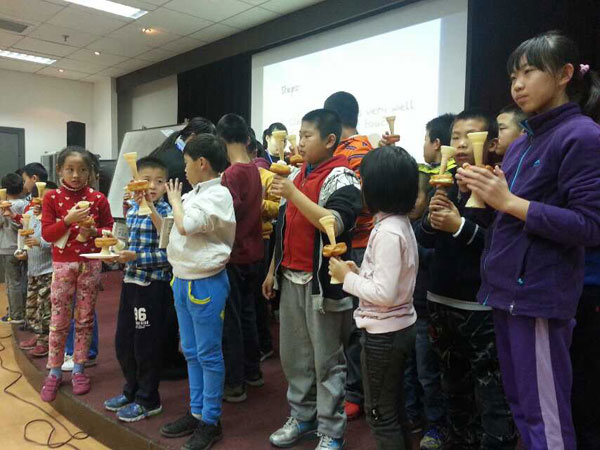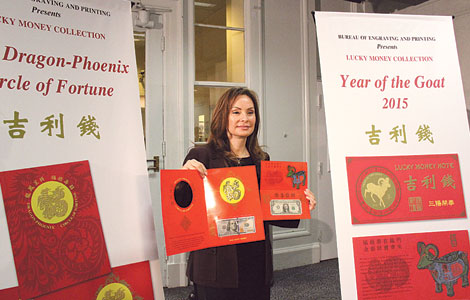Beijing and Mexico reach together for stars
Updated: 2014-12-01 04:08
By Zhang Yuchen in Beijing(China Daily Latin America)
|
||||||||
 |
|
About 300 children took part in the workshop of Night of Stars on Nov 29 at Beijing Planetarium. Provided by UNAM |
The Beijing Planetarium drew about 8,000 Chinese people, mostly children and their parents, to its annual 'Night of Stars' on Nov 29, the event encompassing lectures, workshops and indoor astronomic wonders.
Hosted by the planetarium in cooperation with the Mexican Research Center of the National Autonomous University of Mexico (UNAM) in Beijing, it was the first time since its inception in 2009 that the international astronomic and scientific event tapped Mexican astronomers.
The one-day event had three main parts, including lectures, workshops and astronomical observations held indoors because of the city's smog.
Guillermo Pulido, director of BFSU-UNAM Mexico Research Center, said the goal is to let children fall in love with the marvel of the universe.
"In Mexico we have a special taste for astronomy," said Nahiely Flores Fajardo, a Mexican astronomer visiting Peking University, and who gave lectures at the event. "This discipline has been the gateway to a wider audience contact with science. In this sense, the 'Night of Stars' tries to strengthen scientific culture through astronomy in all strata of the population, combining the efforts of scientific institutions.''
'Night of Stars' was first held under the International Year of Astronomy 2009, which was preceded by a large observation of a lunar eclipse in February 2008 in the Zocalo of Mexico City. It was done in collaboration with French astronomers, who then held 'Night of Stars' in more than 400 locations every year since 1991.
The ultimate goal, according to organizers, is have 'Night of Stars' become a big party held across the country and build a culture of science through astronomy.
This year China and Colombia have been invited to join as new member countries. Because of the time difference, Beijing was the first city to embrace the nighttime sky observation global event. More than 500,000 people worldwide are estimated to have so far participated. For the International Year of Crystallography this year, the topic was 'The Universe in the eye of the beholder'.
"China and Mexico share striking similarities in terms of the sky observation and the Maya's rule of laws, derived from their astronomical studies and research," said Dr Qi Rui, one of the lecturers from the Beijing Planetarium. "It is a great chance for the majority of the Chinese participants to meet their curiosities."
It was also a chance for a family outing with meaningful exploration during the weekend, said Dr Chen Dongni of the planetarium. She said hopefully it will be a routine astronomical event for the planetarium as well as across the country.
More than 100,000 people participated in this astronomical activity last year and now the network of 'Night of Stars' is made up of more than 50 campuses in 31 states in Mexico, aligned with 250 international astronomers.
"We linked the professional astronomers from the international community and we have a good cooperation with China," said Flores Fajardo. "And each time it is greater."
zhangyuchen@chinadaily.com.cn

 US jeweler goes after China's love of diamonds
US jeweler goes after China's love of diamonds
 US Treasury 'Lucky Money' Honors Year of the Goat
US Treasury 'Lucky Money' Honors Year of the Goat
 China-US Internet Forum in DC
China-US Internet Forum in DC
 Shanghai native creates mini car by hand
Shanghai native creates mini car by hand
 2014 Victoria's Secret Fashion Show
2014 Victoria's Secret Fashion Show
 World AIDS Day marked around the world
World AIDS Day marked around the world
 Chinatown told through photos of peoples' rooms
Chinatown told through photos of peoples' rooms
 Creative products by Palace Museum
Creative products by Palace Museum
Most Viewed
Editor's Picks

|

|

|

|

|

|
Today's Top News
Database to track Chinese fugitives overseas
China's Wanda Group in talks to buy Lions Gate stake
Foreign firms set for tougher tax scrutiny in China
Hong Kong protest founders turn themselves in
China-US Internet Forum in DC
Sanya resort unveils Tesla charging stations
Using the present to preserve the past
Chinese investors helping build major US road link
US Weekly

|

|







